2016 Seminar Series
Thursday 8th December, 2016. Ecological restoration of anthropogenically disturbed landscapes often involves the reconnection of isolated fragments in a disturbed matrix. Thermal tolerance and energetic requirements of hymenopteran pollinators were overlaid on topoclimatic models to provide thermo-energetic models of a restoration Biography Sean Tomlinson is a Research Fellow at Curtin University and a Research Scientist at Kings Park & Botanic Gardens in Western Australia where he studies trade-offs and interactions between physiological or morphological adaptations and social and behavioural adaptations to the environment Thursday 8th December, 2016. There is much talk about being able to sequester C in soils and a scheme is in place in Australia to reward farmers for such accumulations. This seminar will demonstrate how difficult this is to achieve. Most disturbed soils have lower total C concentrations than natural systems but the C present is Biography Graeme completed his PhD at Sydney University, was a Post-Doctoral Fellow at the University of Guelph in Canada and began working at UNE in 1970. After retiring in 2002, he has continued as an Honorary Fellow and most recently an Adjunct Professor. In 2000 he received the prestigious International Fertilizer Wednesday 9th November, 2016. Iceland is a unique entity on planet Earth. Its tectonic position and development since the mid-Miocene has led to formation of a dynamic landmass dominantly created by volcanic processes, modified by ice, water and wind, and more recently by human activities. The present co-incidence of the Mid-Atlantic Biography Paul Ashley is an Adjunct Associate Professor in Earth Sciences at UNE, being a staff member between 1985-2008, and casually employed in 2011-2013, following an earlier career in the minerals industry, and gaining of a BSc from the University of Sydney and PhD from Macquarie University. He has had broad Wednesday 26th October, 2016. This presentation will discuss energy at large and then concentrate on electrical energy from traditional sources through to new and emerging areas. Rex will discuss how the sector is changing dramatically to address economic and environmental imperatives and community expectations, including security. Biography Prior to academia Rex worked for a state government road authority, several local government authorities, including Norfolk Island and at various stages, his own consultancy. Rex has been employed in the Civil and Environmental Engineering discipline at the University of New England for varying periods Wednesday 19th October, 2016. The endangered snow leopard (Pantherauncia) is an iconic wildcat of 12 Asian countries. It is an important predator that regulates the alpine ecosystems, most of which are located in the water towers of Asia. Saving this magnificent but sadly dwindling species can help save the water sources that sustain the livelihood Biography Dr Phuntsho Thinley is an Endeavour Postdoctoral Research Fellow at UNE and works as the Principal Research Officer at the Ugyen Wangchuck Institute of Conservation and Environment in the Royal Government of Bhutan. His main interest is studying human-wildlife interactions to mitigate human-wildlife Wednesday 28th September, 2016. The bell miner Manorina melanophrys is the smallest of the miners. More often heard than seen, this species lives in large colonies and aggressively defends their territories against all intruders. They are endemic to eastern and south-eastern mainland Australia, restricted to coastal and mountain regions Biography Dr Kathryn Lambert completed her PhD at UNE in 2015. She has since been working with Northern Tablelands Local Lands Services and Department of Primary Industries as an ecological consultant. She has also been a Lecturer in Zoology since April, specialising in Vertebrate Evolution. Recently she was Wednesday 14th September, 2016. In the vast dunefields of the Gibson Desert, a battle wages between the fire-sensitive shrub Aluta maisonneuvei (desert myrtle) and grasses of the widespread genus Triodia (spinifex). Triodia grasslands accumulate fuels after high rainfalls, and burn regularly and intensely. On the other hand, Aluta heaths rarely burn as fuels cannot accumulate beneath The talk also includes a photographic journey of the Gibson Desert through images captured on the 2015 Bush Blitz scientific expedition to the Kiwirrkurra Indigenous Protected Area (IPA). In this segment, details and images of an ethno-ecological study on the edible grubs of the Pintupi-Luritja Aboriginal Biography Dr Boyd Wright is a fire ecologist and para-professional Pintupi-Luritja interpreter. He has been researching fire and working and living intermittently among the Pintupi-Luritja people in the Western Desert since 2002. He is currently based in Botany at UNE. Wednesday 31st August, 2016. Individuals gain valuable information by eavesdropping on the signals of other species, so forming ecological “information webs”. The flow of information, just like material resources, potentially affects individual fitness and community resilience. I focus on avian eavesdropping on other Biography Rob Magrath is a behavioural ecologist at the ANU. He has worked primarily of birds, including on their breeding ecology, social behaviour and acoustic communication. He did his Hons degree at Monash University and PhD at the University of Cambridge. Wednesday 20th July, 2016. The Cambrian Explosion was a major biodiversification event that saw the rise of nearly all animal phyla in a rapid burst over 500 million years ago. The anomalocaridids are iconic members of these early animal ecosystems, owing to their large size, bizarre morphology and complicated history of description. Biography Allie received her PhD from Uppsala University in 2010. She spent two years at the Natural History Museum in London before moving to Oxford in September 2013. Allie jointly holds positions at the Oxford University Museum of Natural History, and as a Junior Research Fellow at St Edmund Hall. In 2016, Wednesday 20th July, 2016. Bats are incredible animals, being the only mammal capable of true flight and the second largest order of mammals in the world. Because of their small body size and ability to fly, they occupy a wide range of habitats and have developed varying strategies to cope with the constraints associated with Biography Anna is a PhD student at the University of New England and is interested in using physiological and ecological principles to answer questions regarding activity and energy use in small mammals. She is particularly interested in insectivorous bats because of their ability to fly as well as their comparatively Wednesday 6th July, 2016. Globally, climate change is already causing an increase in the occurrence of destructive wildfires, changing the physical and biological characteristics of many ecosystems. While fires are an important natural phenomenon that can rejuvenate landscapes and increase biodiversity, many species may not Biography Clare is interested in combining the fields of physiology and ecology to answer questions related to how animals cope with the energetic challenges they face regularly in their environment. In particular, how they cope physiologically and behaviourally with detrimental weather and environmental conditions Wednesday 22nd June, 2016. David Andrews Bolivia Hill Upgrade The Bolivia Hill upgrade involves the realignment of a 2.1km section of the New England Highway at Bolivia Hill between Glen Innes and Tenterfield. Together with terrain constraints, the existence of the spotted-tailed quoll, and the Bolivia wattle has required innovative design to avoid and minimise Country bridge solutions Local councils, as road authorities, face the growing challenge of maintaining and eventually replacing ageing bridges on Regional and Local roads. The NSW Government is developing Country Bridge Solutions (CBS) to help councils meet this challenge. It is a modular bridge system developed by Roads and Adam Cameron A new Clarence River crossing Planning for an additional crossing of the Clarence River at Grafton was initially funded by the NSW Government, starting from 2002. A community update issued in December 2010 identified 13 preliminary route options and invited community comment via a postal survey. Subsequent phone and business surveys In January 2012, six route options were announced for further investigation. The short-listed options and short-listing process are documented in the Preliminary Route Options Report – Final (RMS, January 2012). The visualisation which will be shown today was a tool that the project team used Wednesday 15th June, 2016. A long held debate in marine geology has pondered how the extreme environmental conditions of the deep seafloor restrict explosive eruptions and if such explosivity can occur at all. This debate is rooted in the physical and chemical characteristics of deep-sea sedimentary deposits. Recent submersible Biography My research is focused on physical and chemical Mid-ocean ridge processes, submarine volcanology and sedimentology. My roots are in land-based field work, but have moved into the marine realm for the last 5 years. Wednesday 8th June, 2016. Torpor, the ability of some animals to temporarily reduce body temperature and metabolic rate, has long been related to survival of seasonal bottlenecks in primarily cold habitats. However, findings of torpor use in species living in tropical habitats have challenged this view and recently it has become Biography Dr Julia Nowack is an ecophysiologist interested in thermoregulation of mammals and the ability of heterothermic animals to use torpor during unpredictable bottlenecks. She completed her PhD at the University of Hamburg in Germany and in 2014 came to Australia to work at the University of New England. Wednesday 11th May, 2016. As our capital cities grow outwards, consuming food-producing lands to suffice the Australian dream of a free standing house, biodiversity of soil ecosystems and drainage patterns are lost to concrete motorways, paved areas and urban sprawl. This presentation will examine the South-West Growth area Biography Dr Bob Patterson operates Lanfax Laboratories in Armidale, specialising in soil, water and wastewater management. Bob graduated from UNE with First Class Honours in B. Nat.Res and went on to complete his PhD at UNE. As a consultant, Bob has been involved in many Land & Environment Court Wednesday 27th April, 2016. The spread of agriculture and pastoralism and how these technologies influenced prehistoric lifeways culturally, environmentally, and biologically has interested researchers for centuries. Eastern Europe was one path the movement of people and ideas took from the Fertile Crescent into the rest of Europe Biography Sarah Ledogar is a PhD candidate at the University at Albany and Doctoral Fellow at the New York State Museum. She is an anthropological archaeologist interested in studying prehistoric animal use using geochemical and zooarchaeological analyses. She works primarily in Ukraine, but she has also worked Wednesday 30th March, 2016. The evolution of the modern human cranium is characterized by a reduction in the relative size of the feeding system. Compared with australopiths, an extinct group of early hominins from which modern humans are likely to be descended, humans exhibit marked reductions in the size of the facial skeleton, Biography Justin Ledogar received his PhD from the University at Albany in 2015. He has held a postdoctoral position at UNE in the Function, Evolution and Anatomy Research (FEAR) Lab since 2015. Justin is a biological anthropologist, with a primary research focus on feeding biomechanics and craniofacial evolution Wednesday 16th March, 2016. Unbalanced endemic island faunas lack mammalian predators, and, as a result, evolution takes courses which fundamentally differ from those on the mainland. For example, large animals, such as Hippopotamids, tend to dwarf to a fraction of their ancestor’s size once isolated. Additional key insular Biography Anneke van Heteren did her PhD at the University of Roehampton in London, held a postdoctoral position at the Muséum national d’Histoire naturelle in Paris and was awarded a fellowship from the Humboldt Foundation to conduct research at the University of Bonn (Germany). Recently, she was appointed Wednesday 2nd March, 2016. This is a seminar about people; their environment, their future, and whether they will have either. Some in the audience will find my words confronting. I make no apologies. There is no time for apologies. Nor do we have choices. We act now, decisively, and with pain or we will be hated by our children’s I am committed to open debate on Australia's environmental and population problems and the need to redefine national priorities in the use of Australia's natural resources. These are discussions that do not happen. To achieve this, I consider it essential to provide conservation scientists with better Biography Harry Recher held positions at the Australian Museum, Sydney University, and the UNE before his appointment as Foundation Professor of Environmental Management at Edith Cowan University in 1995. Professor Recher was awarded the Order of Australia in 2004. He retired in 2003, but maintains an active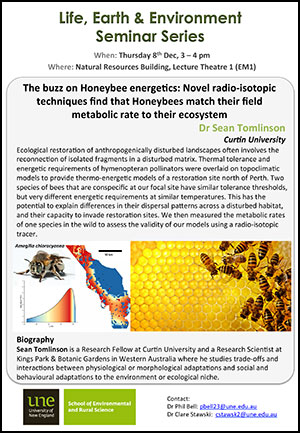
site north of Perth. Two species of bees that are conspecific at our focal site have similar tolerance thresholds, but very different energetic requirements at similar temperatures. This has the potential to explain differences in their dispersal patterns across a disturbed habitat, and their capacity
to invade restoration sites. We then measured the metabolic rates of one species in the wild to assess the validity of our models using a radio-isotopic tracer.
or ecological niche.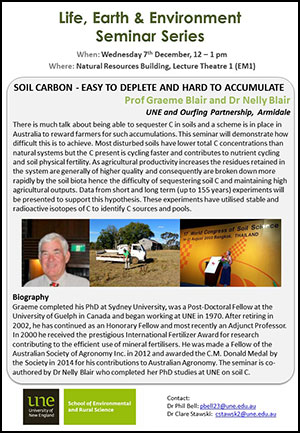
cycling faster and contributes to nutrient cycling and soil physical fertility. As agricultural productivity increases the residues retained in the system are generally of higher quality and consequently are broken down more rapidly by the soil biota hence the difficulty of sequestering soil C and maintaining
high agricultural outputs. Data from short and long term (up to 155 years) experiments will be presented to support this hypothesis. These experiments have utilised stable and radioactive isotopes of C to identify C sources and pools.
Award for research contributing to the efficient use of mineral fertilisers. He was made a Fellow of the Australian Society of Agronomy Inc. in 2012 and awarded the C.M. Donald Medal by the Society in 2014 for his contributions to Australian Agronomy. The seminar is co-authored by Dr Nelly Blair who
completed her PhD studies at UNE on soil C.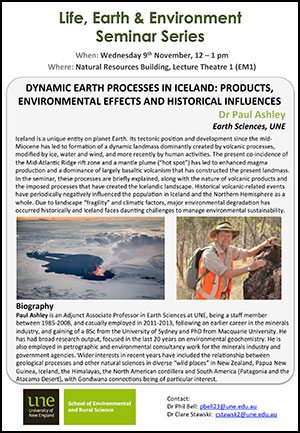
Ridge rift zone and a mantle plume (“hot spot”) has led to enhanced magma production and a dominance of largely basaltic volcanism that has constructed the present landmass. In the seminar, these processes are briefly explained, along with the nature of volcanic products and the imposed processes
that have created the Icelandic landscape. Historical volcanic-related events have periodically negatively influenced the population in Iceland and the Northern Hemisphere as a whole. Due to landscape “fragility” and climatic factors, major environmental degradation has occurred historically
and Iceland faces daunting challenges to manage environmental sustainability.
research output, focused in the last 20 years on environmental geochemistry. He is also employed in petrographic and environmental consultancy work for the minerals industry and government agencies. Wider interests in recent years have included the relationship between geological processes and other
natural sciences in diverse “wild places” in New Zealand, Papua New Guinea, Iceland, the Himalayas, the North American cordillera and South America (Patagonia and the Atacama Desert), with Gondwana connections being of particular interest.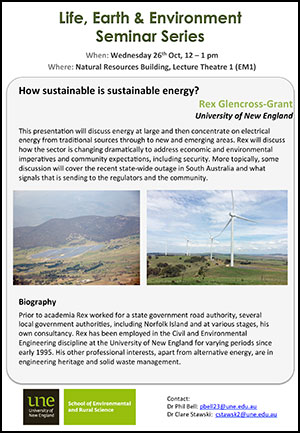
More topically, some discussion will cover the recent state-wide outage in South Australia and what signals that is sending to the regulators and the community.
since early 1995. His other professional interests, apart from alternative energy, are in engineering heritage and solid waste management.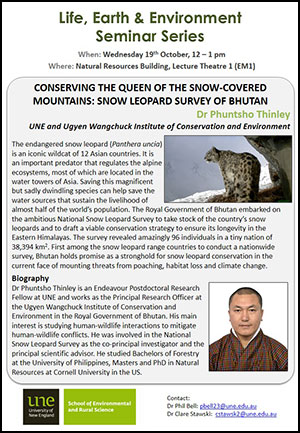
of almost half of the world’s population. The Royal Government of Bhutan embarked on the ambitious National Snow Leopard Survey to take stock of the country’s snow leopards and to draft a viable conservation strategy to ensure its longevity in the Eastern Himalayas. The survey revealed amazingly
96 individuals in a tiny nation of 38,394 km2. First among the snow leopard range countries to conduct a nationwide survey, Bhutan holds promise as a stronghold for snow leopard conservation in the current face of mounting threats from poaching, habitat loss and climate change.
conflicts. He was involved in the National Snow Leopard Survey as the co-principal investigator and the principal scientific advisor. He studied Bachelors of Forestry at the University of Philippines, Masters and PhD in Natural Resources at Cornell University in the US.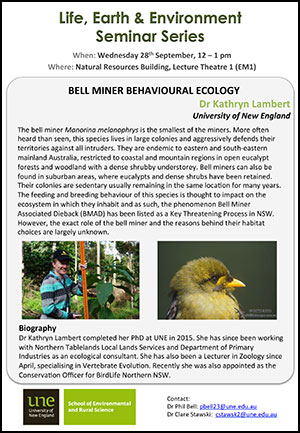
in open eucalypt forests and woodland with a dense shrubby understorey. Bell miners can also be found in suburban areas, where eucalypts and dense shrubs have been retained. Their colonies are sedentary usually remaining in the same location for many years. The feeding and breeding behaviour of this
species is thought to impact on the ecosystem in which they inhabit and as such, the phenomenon Bell Miner Associated Dieback (BMAD) has been listed as a Key Threatening Process in NSW. However, the exact role of the bell miner and the reasons behind their habitat choices are largely unknown.
also appointed as the Conservation Officer for BirdLife Northern NSW.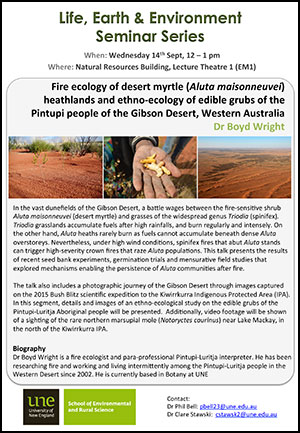
dense Aluta overstoreys. Nevertheless, under high wind conditions, spinifex fires that abut Aluta stands can trigger high-severity crown fires that raze Aluta populations. This talk presents the results of recent seed bank experiments, germination trials and mensurative field
studies that explored mechanisms enabling the persistence of Aluta communities after fire.
people will be presented. Additionally, video footage will be shown of a sighting of the rare northern marsupial mole (Notoryctes caurinus) near Lake Mackay, in the north of the Kiwirrkurra IPA.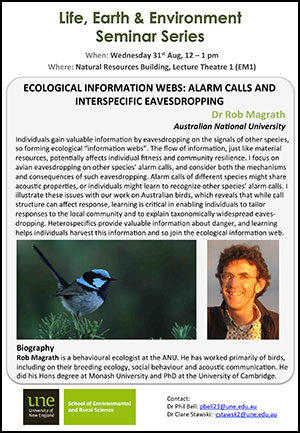
species’ alarm calls, and consider both the mechanisms and consequences of such eavesdropping. Alarm calls of different species might share acoustic properties, or individuals might learn to recognise other species’ alarm calls. I illustrate these issues with our work on Australian birds,
which reveals that while call structure can affect response, learning is critical in enabling individuals to tailor responses to the local community and to explain taxonomically widespread eaves- dropping. Heterospecifics provide valuable information about danger, and learning helps individuals harvest
this information and so join the ecological information web.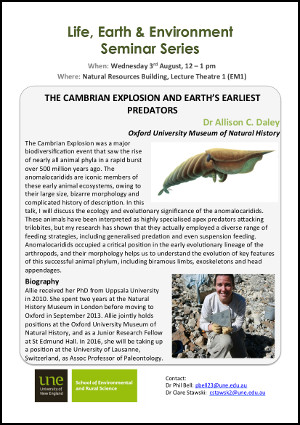
In this talk, I will discuss the ecology and evolutionary significance of the anomalocaridids. These animals have been interpreted as highly specialised apex predators attacking trilobites, but my research has shown that they actually employed a diverse range of feeding strategies, including generalised
predation and even suspension feeding. Anomalocaridids occupied a critical position in the early evolutionary lineage of the arthropods, and their morphology helps us to understand the evolution of key features of this successful animal phylum, including biramous limbs, exoskeletons and head appendages.
she will be taking up a position at the University of Lausanne, Switzerland, as Assoc Professor of Paleontology.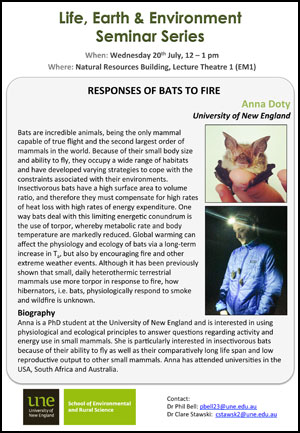
their environments. Insectivorous bats have a high surface area to volume ratio, and therefore they must compensate for high rates of heat loss with high rates of energy expenditure. One way bats deal with this limiting energetic conundrum is the use of torpor, whereby metabolic rate and body temperature
are markedly reduced. Global warming can affect the physiology and ecology of bats via a long-term increase in Ta, but also by encouraging fire and other extreme weather events. Although it has been previously shown that small, daily heterothermic terrestrial mammals use more torpor in response to fire, how hibernators, i.e. bats, physiologically respond to smoke and wildfire is unknown.
long life span and low reproductive output to other small mammals. Anna has attended universities in the USA, South Africa and Australia.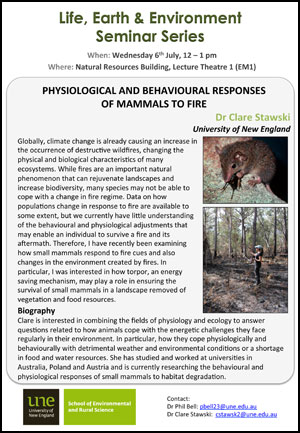
be able to cope with a change in fire regime. Data on how populations change in response to fire are available to some extent, but we currently have little understanding of the behavioural and physiological adjustments that may enable an individual to survive a fire and its aftermath. Therefore, I have
recently been examining how small mammals respond to fire cues and also changes in the environment created by fires. In particular, I was interested in how torpor, an energy saving mechanism, may play a role in ensuring the survival of small mammals in a landscape removed of vegetation and food resources.
or a shortage in food and water resources. She has studied and worked at universities in Australia, Poland and Austria and is currently researching the behavioural and physiological responses of small mammals to habitat degradation.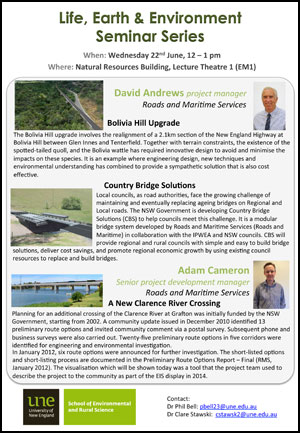
Project manager, Roads and Maritime Services
the impacts on these species. It is an example where engineering design, new techniques and environmental understanding has combined to provide a sympathetic solution that is also cost effective.
Maritime Services (Roads and Maritime) in collaboration with the IPWEA and NSW councils. CBS will provide regional and rural councils with simple and easy to build bridge solutions, deliver cost savings, and promote regional economic growth by using existing council resources to replace and build
bridges.
Senior project development manager, Roads and Maritime Services
were also carried out. Twenty-five preliminary route options in five corridors were identified for engineering and environmental investigation.
to describe the project to the community as part of the EIS display in 2014.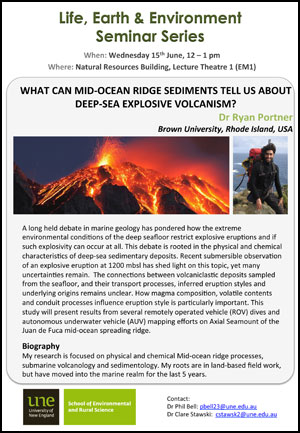
observation of an explosive eruption at 1200 mbsl has shed light on this topic, yet many uncertainties remain. The connections between volcaniclastic deposits sampled from the seafloor, and their transport processes, inferred eruption styles and underlying origins remains unclear. How magma
composition, volatile contents and conduit processes influence eruption style is particularly important. This study will present results from several remotely operated vehicle (ROV) dives and autonomous underwater vehicle (AUV) mapping efforts on Axial Seamount of the Juan de Fuca mid-ocean spreading
ridge.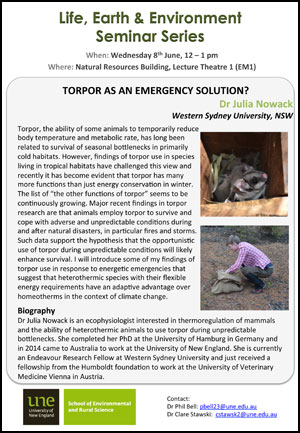
evident that torpor has many more functions than just energy conservation in winter. The list of “the other functions of torpor” seems to be continuously growing. Major recent findings in torpor research are that animals employ torpor to survive and cope with adverse and unpredictable conditions
during and after natural disasters, in particular fires and storms. Such data support the hypothesis that the opportunistic use of torpor during unpredictable conditions will likely enhance survival. I will introduce some of my findings of torpor use in response to energetic emergencies that suggest
that heterothermic species with their flexible energy requirements have an adaptive advantage over homeotherms in the context of climate change.
She is currently an Endeavour Research Fellow at Western Sydney University and just received a fellowship from the Humboldt foundation to work at the University of Veterinary Medicine Vienna in Austria.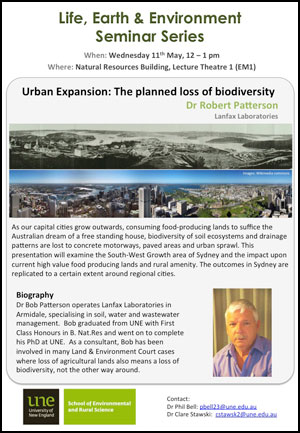
of Sydney and the impact upon current high value food producing lands and rural amenity. The outcomes in Sydney are replicated to a certain extent around regional cities.
cases where loss of agricultural lands also means a loss of biodiversity, not the other way around.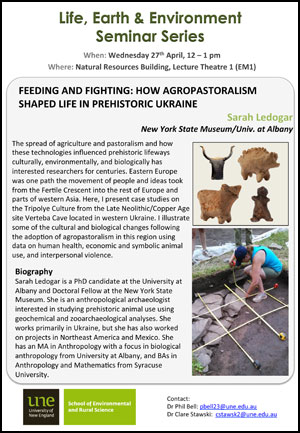
and parts of western Asia. Here, I present case studies on the Tripolye Culture from the Late Neolithic/Copper Age site Verteba Cave located in western Ukraine. I illustrate some of the cultural and biological changes following the adoption of agropastoralism in this region using data on human health,
economic and symbolic animal use, and interpersonal violence.
on projects in Northeast America and Mexico. She has an MA in Anthropology with a focus in biological anthropology from University at Albany, and BAs in Anthropology and Mathematics from Syracuse University.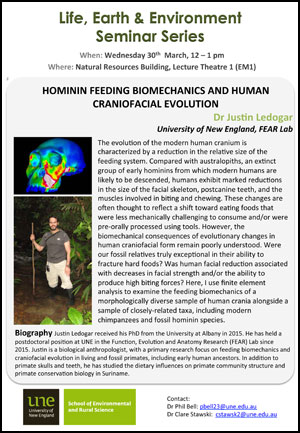
postcanine teeth, and the muscles involved in biting and chewing. These changes are often thought to reflect a shift toward eating foods that were less mechanically challenging to consume and/or were pre-orally processed using tools. However, the biomechanical consequences of evolutionary changes in
human craniofacial form remain poorly understood. Were our fossil relatives truly exceptional in their ability to fracture hard foods? Was human facial reduction associated with decreases in facial strength and/or the ability to produce high biting forces? Here, I use finite element analysis to examine
the feeding biomechanics of a morphologically diverse sample of human crania alongside a sample of closely-related taxa, including modern chimpanzees and fossil hominin species.
in living and fossil primates, including early human ancestors. In addition to primate skulls and teeth, he has studied the dietary influences on primate community structure and primate conservation biology in Suriname.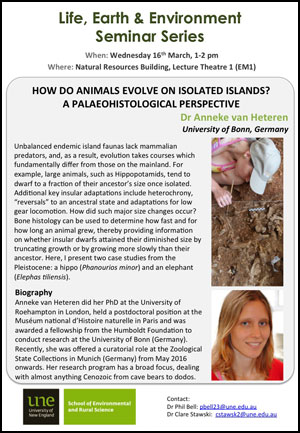
adaptations include heterochrony, “reversals” to an ancestral state and adaptations for low gear locomotion. How did such major size changes occur? Bone histology can be used to determine how fast and for how long an animal grew, thereby providing information on whether insular dwarfs attained
their diminished size by truncating growth or by growing more slowly than their ancestor. Here, I present two case studies from the Pleistocene: a hippo (Phanourios minor) and an elephant (Elephas 0liensis). L.
as curator at the Zoological State Collections in Munich (Germany) from May 2016 onwards. Her research program has a broad focus, dealing with almost anything Cenozoic from cave bears to dodos.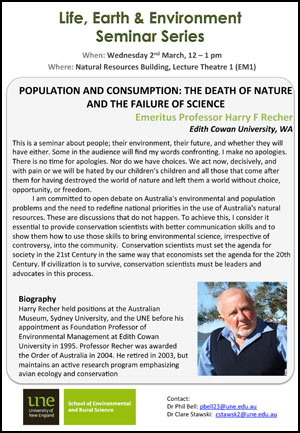
children and all those that come after them for having destroyed the world of nature and left them a world without choice, opportunity, or freedom.
communication skills and to show them how to use those skills to bring environmental science, irrespective of controversy, into the community. Conservation scientists must set the agenda for society in the 21st Century in the same way that economists set the agenda for the 20th Century. If civilization
is to survive, conservation scientists must be leaders and advocates in this process.
research program emphasizing avian ecology and conservation.

